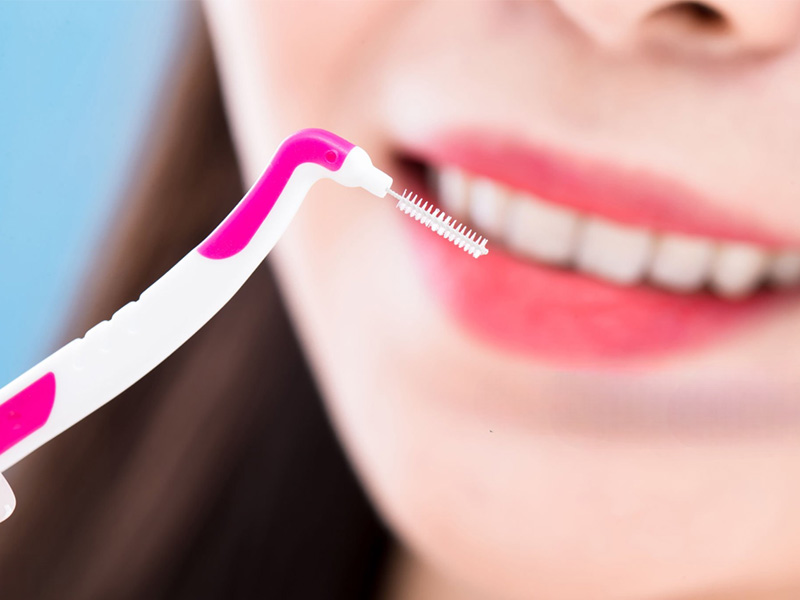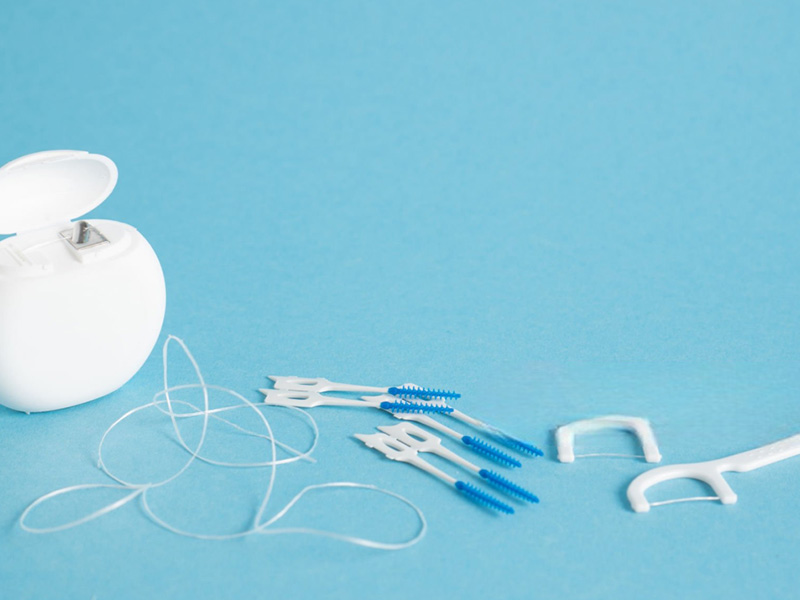
Interdental Brushes vs. String Floss: Find the Best Tool for Your Teeth
This article will help you understand the difference between interdental brushes and string floss. You will know how to pick the best one for your mouth. This will help you improve your oral hygiene and get a healthier, happier smile.
Table of Contents
What is Interdental Cleaning and Why Does It Matter for Your Oral Health?
A toothbrush can only clean the front, back, and top surfaces of your teeth. It cannot reach the tight spaces between them. These spaces make up a huge part of your tooth surface. When you don’t clean there, you leave behind food and germs. This creates a sticky, clear film called plaque. This plaque is the main cause of many dental problems.
This is where interdental cleaning comes in. It means cleaning between your teeth. This is a vital step for good oral health. If you let plaque build up, it can harden into tartar. This can lead to serious issues like tooth decay and gum disease. Taking a moment each day for regular interdental cleaning is a crucial aspect of oral hygiene. It helps you maintain your overall oral health and prevent problems before they start. Doing this is key to maintaining optimal oral health.
The Classic Choice: What Exactly is String Floss?
When most people think about cleaning between their teeth, they think of dental floss. Traditional floss, or string floss, is a thin thread. It is usually made of nylon or plastic. You wrap it around your fingers and gently pull it between your teeth. The main job of the floss is to scrape away plaque and food from where your toothbrush can’t reach. Flossing helps a lot with maintaining good oral hygiene.
The key to using floss right is the technique. You have to slide it up and down against the sides of each tooth. You should make a “C” shape with the floss to hug the tooth. This ensures you clean the teeth and below the gumline. For some people, this can be tricky to do, especially on back teeth. But when done right, floss can be very effective. The benefits of flossing are clear, and many dental experts recommend it. Flossing is a crucial aspect of dental care.

What is an Interdental Brush? Is it a Tiny Toothbrush?
An interdental brush is another tool for cleaning between your teeth. And yes, it is basically a tiny toothbrush. Interdental brushes are small. They have a small, cone-shaped or cylinder-shaped brush head with bristles. This little brush is attached to a thin wire with a handle, making it easy to hold. The design of this small interdental brush is perfect for getting into the gaps between your teeth.
These small brushes are designed to do the same job as floss: remove plaque and food particles. The big difference is that an interdental brush scrubs the area instead of scraping it. They come in different sizes to fit different interdental spaces. You need to find the right size for your mouth. A good brush will fit snugly but not feel forced. Using an interdental brush can be a great addition to your oral hygiene practices.
Dental Floss vs Interdental Brush: The Main Showdown
So, let’s look at the big comparison: dental floss vs interdental brush. The main difference is how they work. Dental floss is a thin string. You use it to get into very tight spaces. It scrapes the plaque off. An interdental brush is a bristled brush. It scrubs the surfaces between your teeth. Think of it like using a broom versus a mop. Both clean, but in different ways.
The debate of interdental brush vs string floss often comes down to personal preference and the shape of your mouth. Some people find it easier to use an interdental brush. Others feel that floss gives a cleaner feeling. This is the core of the floss vs interdental debate. There are pros and cons to both. The right choice in the vs interdental brushes battle depends on you.
Are Interdental Brushes Better at Removing Plaque?
Mmany studies show an interdental brush can be more effective in removing plaque, especially in places with larger gaps. The bristles on the brush can reach into all the little corners and curves between teeth. This means the brush can clean more surface area at once, leading to better plaque removal.
However, this doesn’t mean you should throw your floss away. For people with very tight teeth, a thin piece of floss might be the only tool that can fit. If an interdental brush is too big, forcing it can hurt your gums. The most important thing is to remove plaque every day. Whether you use floss or a brush, the goal is to prevent tooth decay and gum disease. The best tool is the one that works for your teeth and that you will use consistently.
When Should You Choose an Interdental Brush vs. String Floss?
The choice between an interdental brush and floss often depends on your specific dental needs. For example, people with a brace often find an interdental brush much easier to use. The little brush can get under the wires and around the brackets of the brace much better than floss can. The same is true for people with dental implants, dental bridges, or large gaps between their teeth. The interdental brush can clean these areas very well.
On the other hand, you should use floss if your teeth are very crowded and close together. In these cases, a piece of floss may be the only thing that can slide between the teeth. Some people even use both. They use an interdental brush for their back teeth or where they have a brace, and they use floss for their tighter front teeth. It’s a good idea to talk with your dentist about what works for you. Using an interdental brush with your brace can be a game-changer for your dental hygiene.
How to Use an Interdental Brush Correctly?
Using an interdental brush is often simpler than using floss, which is a big reason people like them. First, you need to choose the right size. If you are not sure, start with the smallest size. You can also ask your dentist for help. You should never force the brush into a space. Gently insert the brush into the gap between your teeth.
Once the interdental brush is in, simply move the brush back and forth a few times. Do this for each space between your teeth. You don’t need to be rough. A gentle motion is all you need to remove the debris from between the teeth. After you are done with one space, rinse the brush with water before moving to the next one. This ease of use makes it easier for people to stick to their daily oral hygiene routine.
What About Other Tools like a Water Flosser or Interdental Picks?
The world of dental care has more than just floss and brushes. You might have heard of a water flosser. A water flosser shoots a thin stream of water to clean between your teeth. It’s great for getting rid of food particles and bacteria. Many people with a brace or very sensitive gums love using a water flosser. It can be a great tool to enhance your oral health.
You can also find interdental picks. These are often small plastic tools with a piece of floss stretched across a handle, like the Summit Oral Care floss picks. For people who have trouble wrapping string floss around their fingers, these are a great alternative. The convenience of interdental picks compared to floss makes them very popular. Summit Oral Care® offers innovative preventive oral care products. Their line of oral care products gives you many choices. It’s good to know all the options to find what helps you most.

How to Find the Best Interdental Cleaning Tool for You?
Finding the best tool is a personal journey. The right choice depends on the size of the gaps between your teeth, your dental work, and what you find easiest to use. A great first step is to talk to your dentist or one of the dental hygienists at your clinic. They can look at your teeth and give you a personal recommendation. They can even measure your interdental spaces to help you find interdental brushes that fit perfectly.
You can also try a variety pack of interdental brushes. These packs come with several different sizes. This lets you test them at home and see which brush feels best. The main goal is to build a solid oral health routine that you can follow every single day. Regular dental check-ups can also help you stay on track. This is how you achieve better oral health and prevent serious oral health issues.
What Should Be in Your Oral Care Kit?
The best approach is to use both. Use a small interdental brush for your back molars. The gaps are a bit larger there, and the brush does an amazing job cleaning them. Use floss for your front teeth, which are much closer together. This combination helpsyoue make sure you clean all the sides of each tooth.
The best interdental cleaning tool is the one you will actually use every day. It does not matter if you choose an interdental brush, floss, or something else. What matters is consistency. Flossing and interdental brushing both play a key role in maintaining optimal oral hygiene. You have to clean between your teeth no matter what. Doing so will help protect your teeth and gums, keep your smile bright, and prevent serious dental problems down the road.




